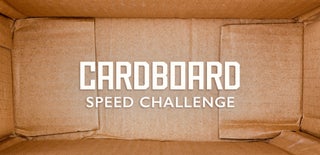Introduction: Super-Sturdy Cardboard Shelving
This is an easy way to take otherwise flimsy cardboard and turn it into something durable that you're willing to display and use in your home. (Dimensions: 36"x15"x5.5" [91.5cmx31cmx14cm])
Most of the other designs I've seen online for cardboard furniture require some combination of specialty cardboard, or intricate cuts, or large and pristine cardboard sheets. Not this bad boy: just collect whatever cardboard you can and start cutting rectangles!
This is my first Instructable, but I'll likely use it as a foundation for future projects because I had a blast making this. Once you finish this project you'll see there are millions of different ways you can customize and personalize.
The design is simple, the material is typically free, the tools are under $10 new, and it's easy to pickup without any pre-existing skill if you follow the instructions I've laid out here.
--
Basically what we'll be doing is i) creating strong triple-corrugated cardboard planks from thinner cardboards, ii) then cutting slot-joints into the planks, and then iii) fitting them into a stable grid-pattern.
In my tests—with the cardboard I found in an alley—and glued together 95% of the way with homemade wheatpaste—this little shelf can hold about 35-45lbs. So, don't expect miracles, but the strength is pretty incredible.
Supplies
- 3-4 large cardboard boxes
- Ruler/measuring tape
- Box cutter/utility knife
- Cutting surface
- Adhesive
- Pencil
- Brush
Optional, but helpful:
- Speed square
- Wood glue
- Clamps
Step 1: Preparing the Materials
Either before hunting for cardboard or after assembling your materials, you'll want to decide a few things:
- The height, width and depth of the final case
- How many shelves it will have
- How many layers of cardboard
As general rules:
- More layers = More strength
- More shelves = More stability
For my project, each of the 3 final shelves is 15"x5.5" (31cmx14cm) and I put in 3 layers to each plank. So for my 3 shelves with 3 layers, I used my tape measure and marked 9 rectangles with my pencil. Then I did the same for my 2 sides of 36"x5.5" [91.5cmx14cm] and marked 6 rectangles for these for 15 rectangles total.
If your cardboard is made up of thinner-style corrugated cardboard (think Amazon boxes), you'll want to go thicker to four or even five layers to get the same strength. The same applies if you want to use smaller pieces to make a longer piece: go thicker, layer up.
Remove any tape and start cutting the boxes...and make sure you have something behind the knife besides the kitchen table! (I used a thick plastic board.) A speed square makes getting straight lines much easier.
Step 2: Gluing Together the 'Planks'
This step is pretty easy: You take your wheatpaste/glue and apply a thin layer to your rectangles before sandwiching them together and placing under something flat and heavy.
For wheatpaste, this takes from a few hours to overnight. For glue thinned with water in a 1:1 ratio, at least 2 hours is required.
Try to get all your planks the same thickness, as this will make the next step easier.
--
Full-strength wood glue is likely overkill, as you get an extremely strong bond between the two paper surfaces of standard cardboard; however, please leave a tip or comment if you have ideas on how the adhesive can be improved!
Step 3: Cutting Slot Joints
This step is pretty easy too!
Measure the thickness of your planks. As all of mine were the same thickness (0.5") it made it easy to repeat the same cut for all joints.
Cut half-depth notches into your planks, leaving a bit of overhang to support the weight on your shelves. On my shelves, I cut 2.5"x0.45" slots at 1.5" in from the ends. It's always better to cut these too small than too large! You can cut out more, but if you cut out too much you may have to start over on that particular piece.
I spaced my shelves 10" apart which left 10" on top and 3.5" on the bottom for legs.
(On the next one of these I build, I'm going to make the lowest shelf even closer to the ground for even more stability.)
Step 4: Fit Shelves Into the Grid
This step is...somehow also easy....Sorry, I'm just not used to projects going this well on the first go.
Anyways, you're 85% of the way there! You should lock the pieces together where you cut your slots.
As you can see, my slots were not perfect the first time. How I fixed this was I measured how much extra lip my shelves had (between 0.125"-0.5") and cut that much more out of the shelf slots. After that, each shelf has a perfect fit and is ready for functionality!
Step 5: Try It Out and Customize
You can glue the shelves together if you like, but honestly, the slots alone are enough to hold this whole thing tight. And, if you move or want to ship one to a friend, it packs flat and weighs almost nothing!
I like the tall walls on the upper shelf as they can hold taller books and magazines that might not fit on another bookshelf.
You can decorate the shelf with paint, paper mache, or wrapping paper if you'd like to hide the underlying material. Personally I like the industrial, unfinished look of the raw cardboard. And it's a great conversation starter.
The extensive Stephen King collection is optional, but Led Zeppelin's "Mothership" is required. I'm going to build another to stress-test how much weight these things can truly hold, but I'm optimistic I can get a similar design to hold over 100lbs with little extra work. ^_^ Updates to come...
Please give some input if you've done something similar or have suggestions for improvement!

Participated in the
Cardboard Speed Challenge










